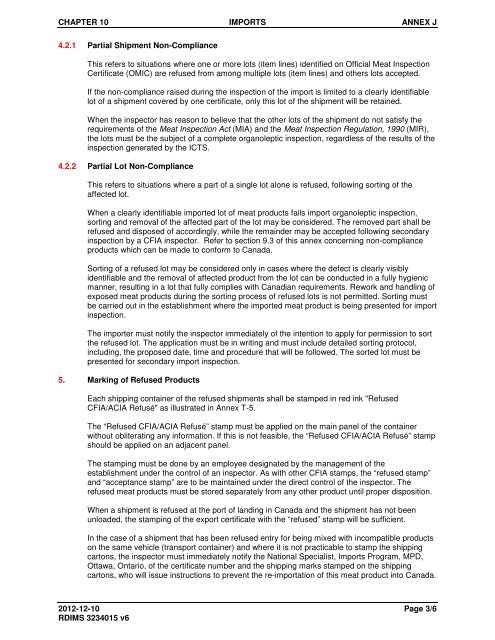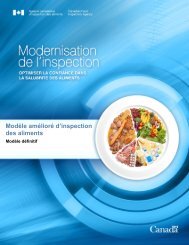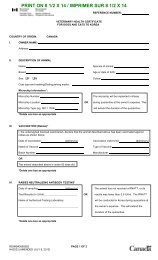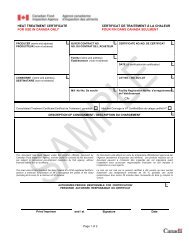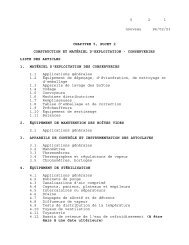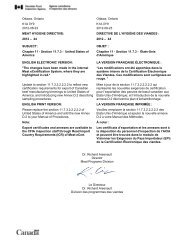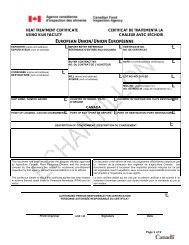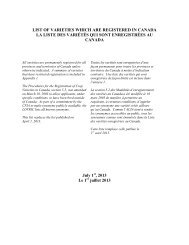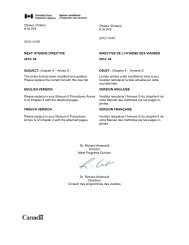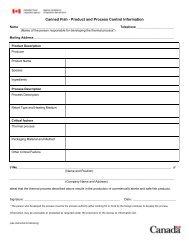PDF (342 kb ) - Agence canadienne d'inspection des aliments
PDF (342 kb ) - Agence canadienne d'inspection des aliments
PDF (342 kb ) - Agence canadienne d'inspection des aliments
You also want an ePaper? Increase the reach of your titles
YUMPU automatically turns print PDFs into web optimized ePapers that Google loves.
CHAPTER 10 IMPORTS ANNEX J4.2.1 Partial Shipment Non-ComplianceThis refers to situations where one or more lots (item lines) identified on Official Meat InspectionCertificate (OMIC) are refused from among multiple lots (item lines) and others lots accepted.If the non-compliance raised during the inspection of the import is limited to a clearly identifiablelot of a shipment covered by one certificate, only this lot of the shipment will be retained.When the inspector has reason to believe that the other lots of the shipment do not satisfy therequirements of the Meat Inspection Act (MIA) and the Meat Inspection Regulation, 1990 (MIR),the lots must be the subject of a complete organoleptic inspection, regardless of the results of theinspection generated by the ICTS.4.2.2 Partial Lot Non-ComplianceThis refers to situations where a part of a single lot alone is refused, following sorting of theaffected lot.When a clearly identifiable imported lot of meat products fails import organoleptic inspection,sorting and removal of the affected part of the lot may be considered. The removed part shall berefused and disposed of accordingly, while the remainder may be accepted following secondaryinspection by a CFIA inspector. Refer to section 9.3 of this annex concerning non-complianceproducts which can be made to conform to Canada.Sorting of a refused lot may be considered only in cases where the defect is clearly visiblyidentifiable and the removal of affected product from the lot can be conducted in a fully hygienicmanner, resulting in a lot that fully complies with Canadian requirements. Rework and handling ofexposed meat products during the sorting process of refused lots is not permitted. Sorting mustbe carried out in the establishment where the imported meat product is being presented for importinspection.The importer must notify the inspector immediately of the intention to apply for permission to sortthe refused lot. The application must be in writing and must include detailed sorting protocol,including, the proposed date, time and procedure that will be followed. The sorted lot must bepresented for secondary import inspection.5. Marking of Refused ProductsEach shipping container of the refused shipments shall be stamped in red ink "RefusedCFIA/ACIA Refusé" as illustrated in Annex T-5.The “Refused CFIA/ACIA Refusé” stamp must be applied on the main panel of the containerwithout obliterating any information. If this is not feasible, the “Refused CFIA/ACIA Refusé” stampshould be applied on an adjacent panel.The stamping must be done by an employee <strong>des</strong>ignated by the management of theestablishment under the control of an inspector. As with other CFIA stamps, the “refused stamp”and “acceptance stamp” are to be maintained under the direct control of the inspector. Therefused meat products must be stored separately from any other product until proper disposition.When a shipment is refused at the port of landing in Canada and the shipment has not beenunloaded, the stamping of the export certificate with the “refused” stamp will be sufficient.In the case of a shipment that has been refused entry for being mixed with incompatible productson the same vehicle (transport container) and where it is not practicable to stamp the shippingcartons, the inspector must immediately notify the National Specialist, Imports Program, MPD,Ottawa, Ontario, of the certificate number and the shipping marks stamped on the shippingcartons, who will issue instructions to prevent the re-importation of this meat product into Canada.2012-12-10 Page 3/6RDIMS 3234015 v6


